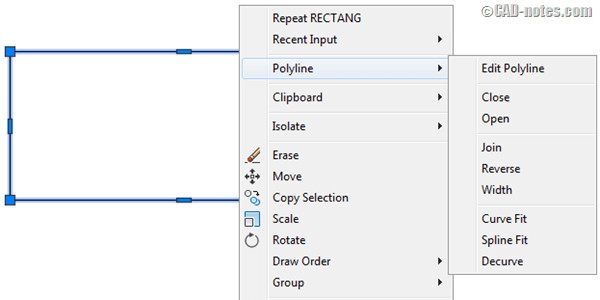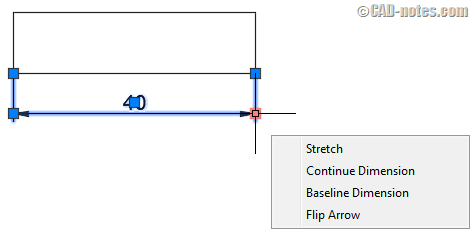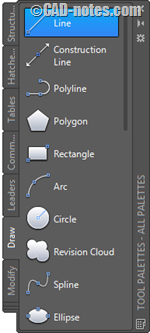AutoCAD Command
How to enter a command using the command line.
Type a command on the command line.
- Choose one of the following options to run the command:
- Type the complete command name in the Command prompt text box and hit Enter or Spacebar.
- Start entering the command if automatic command completion is enabled. When the right command is highlighted in the command text area, press Enter.
- Press Enter to enter the command alias (a shorter, alternative name saved in the .pgp file).
- Use one of the following strategies to respond to any more prompts and options:
- Press Enter to pick the default choice, which is presented in brackets.
- Enter a value or click an area in the artwork to react to a prompt.
- Type the uppercase, highlighted characters in the prompt list and click Enter to choose a prompt choice.
- Click the prompt to choose a prompt choice.
Use a Command You've Already Used
- Choose one of the following options:
- Click within the command line and press the Up or Down Arrow key to cycle through the commands you've entered.
- To the left of the command text box, click the Recent Commands button.
- When you right-click the command line, choose Recent Commands from the context menu.
- Right-click the drawing area and select a command from the Recent Input list.
- Select the command you wish to use by clicking it.
The command is sent again.
Repetition of a Command
Use one of the following methods:
- With the cursor in the Command prompt text box, press Enter or Spacebar once the command has been finished.
- Type numerous times in front of the command.
- Entering numerous circles, for example, will urge you for more circles.
- Right-click anywhere on the screen. (The User Preferences tab of the Options dialogue box is where you specify this behavior.)
Fill out a Command Form
Do one of the following to accept a value or finish a command:
- Enter the code.
- Hold down the Spacebar for a few seconds. Simply right-click and choose Enter, or right-click and choose Enter (depending on right-click behavior settings).
- Note that the instructions in Help presume that you have completed this step and do not directly tell you to do so for each entry.
Abort a Command
Press the Esc key
Concerning Command Lookup
Look for commands in a number of places on the interface.
From the Menu of Applications
At the top of the Application menu is the Command Search field. Menu commands, basic tooltips, and Command prompt text strings may all be found in the search results. A search term can be entered in any language. The outcomes are applicable to the current workspace.
From a command prompt
When you type the first few letters of a command in either the command window or the dynamic input box, a list of recommended commands appears. The list contains the following qualities by default:
- At the top of the list are the most frequently used commands that begin with the letters you type. The priority order of this list varies over time to reflect the commands you use the most.
- If you regularly misspell a command and then pick it, the recommendation list will alter to show that command anytime you misspell it.
- Commands that contain the letters you input, as well as commands that begin with those letters, are included in the suggested list.
To view the list of system variables, press the Tab key. To get more information on the chosen command, use the Search box.
The Customize button Input Settings, located to the left of the command window, provides options for modifying the presentation of the recommendation list.
To Help with Content Research
category-based content search
- Type the keyword that corresponds to the content you want to find at the Command prompt. (Do not hit the Enter key.)
Spell the text as displayed, with no spaces.
- block
- layer
- hatch
- text style
- dim style
- visual design (not available in AutoCAD LT)
A proposal for the content category you choose appears in the command line suggestion list.
- If required, expand the drop-down list next to the category. Hover your mouse over the list items to see a thumbnail preview.
- To use it, select the named object.
Look up content by name.
- Type the name of the material you wish to find at the Command prompt. (Do not hit the Enter key.). A proposal for the content name you gave appears in the command line suggestion list.
- To apply the identified object, choose it and follow the steps.
How to rapidly access an AutoCAD command
AutoCAD is a programmer that has been around for 30 years. It was already in use before it was ported to Windows. Until now, it was built to work on a variety of operating systems and standard interfaces. As a result, there are a number of options for getting AutoCAD commands. While one approach may be quicker in general, another may be faster when doing certain tasks.
For example, most AutoCAD users find that activating line commands through command line is faster. Toggling Ortho mode with the Function keys, however, is quicker. It would be great for you to become acquainted with other ways so that you may select the one that best suits your needs. So, let's look at all of the ways you can utilize AutoCAD commands and see how they may be used efficiently.
- From the AutoCAD Ribbon:
AutoCAD 2009 added the Ribbon feature. If you study AutoCAD after this edition, this will almost certainly be your major way. I discovered that many infrequent users enjoy ribbon as well. I'm not saying that's the greatest technique, but I prefer it over using the toolbar.

Many AutoCAD veterans dislike ribbon because the transition from toolbar to ribbon is so drastic. It feels sluggish (although I believe it improves in later versions) and takes up too much screen space. I don't mind the ribbon since, before to 2009, I didn't use the toolbar much. This is the most apparent way to activate a command in the most recent edition. Even if you've never seen AutoCAD before, you know you can activate a command from here.
- Toolbar for Quick Access
The Quick Access Toolbar comes with a ribbon interface (QAT).

It includes the most often used AutoCAD tools. You can store AutoCAD commands here if you use them frequently. Simply right-click a command and select Add to Quick Access Toolbar from the context menu to add it to the Quick Access Toolbar.
- Toolbar
Before the ribbon, there was a means to launch a command with a graphical user interface called a toolbar. Each toolbar has a number of comparable tools. You must memorize the symbol because there is no label next to it. Yes, there is a tool tip to assist you in recognizing a tool. However, if you just use AutoCAD sometimes, finding a tool is still difficult.

The advantage of employing a toolbar over a Ribbon is that it takes up less space.
- AutoCAD menu
The AutoCAD menu, like the toolbar, is not shown by default. It's only available in Classic Workspace, but it's still functional. I prefer menus because I can always locate the command I'm looking for. I can locate it in the menu if it's not on the ribbon or toolbar. For me, it's more detailed and simpler.

Change the MENUBAR system variable to 1 if you wish to utilize AutoCAD menus. If you'd want to conceal it, change it back to 0.
- Line of Command
Veteran Users of AutoCAD like using the command line. When I show them alternative software, they constantly ask whether it has comparable features. It isn't used by a lot of software. As a result, the command line distinguishes AutoCAD.
Instead of using the mouse and clicking the icons, you may type the commands below.

The command line has improved to the point that even novice users may readily utilize it. If you don't sure what command to use, it will provide AutoCorrect, AutoComplete, and Synonym Suggestions. You don't have to remember the exact command; just type it into the command line and AutoCAD will figure it out for you. Then, from the drop-down option, choose it.
- Menu in Context
A standard Windows interface is the context menu. Every piece of software has it.

When you choose an object and press the right mouse button, a menu connected to the object will appear. What you can do with that particular item.
- Grips with Multiple Functions
When you choose an AutoCAD object, you'll notice that it has a number of grips. By holding the mouse pointer above the grip, you may access different modification tools.

The tools, like the contextual menu, are tied to the object you picked.
- Palette of Tools Tool
Palette is a wonderful approach to activate command if you need to construct an object with certain characteristics. It may be used for a variety of AutoCAD drawing tools, not only inserting blocks.

If you need to draw a line on layer "centerline," for example, you may choose it from the tool palette. Regardless of whatever layer is active, your line will be drawn on the centerline layer.
Customizing the tool pallet is a breeze. Simply drag and drop things onto the palette. - Other locations
You may also activate AutoCAD commands from other places. However, the commands you may use in these areas are limited. The menu of application

The huge A sign represents the application menu. The majority of the commands in this section are file-related. Save, open, print, and recover are only a few examples.
The Navigation Bar and the View Cube
On the right side of your drawing area, you'll find the View Cube and Navigation bar. You may use navigation commands like zoom and pan from here.
Viewport control inside the canvas
To rapidly access Model Viewport, Views, and View Styles, utilize the In-canvas viewport control.
status bar
The Status Bar displays information about your current status. Many buttons may be found at the right bottom of the status bar. Toggle switches are what they are. Here you may rapidly toggle on/off several options. OSNAP and ORTHOMODE, for example.
Using Shortcuts to Run AutoCAD Commands
Let's get to the exciting part. Because AutoCAD provides so many choices for activating instructions, you may employ a variety of shortcuts. You can get to a command faster than clicking the symbol with your mouse - Ribbon command
Yes, shortcuts exist for ribbon as well. You will see letters above the tabs if you press the ALT key once. You'll see letters on each tool if you press H for home.

This is a great technique to rapidly trigger a command if you're using ribbon. Or, without moving your mouse pointer, go to a different tab.
If you enable the menu bar (MENUBAR=1), this shortcut will not work. - Alias Command

You can use the command alias for easier access while using the command line. L is an alias for LINE, for example. EXPLODE is an alias for X. You may easily customize the command alias to suit your needs. For the COPY command, I like to alter CO to CC. The explanation for this is because I can type C twice as quickly as I can type O and make fewer mistakes. If you have Express Tools installed, you can quickly alter command aliases using the Command Aliases tool (ALIASEDIT).
- Shortcut Keys in Windows.
For a long time, AutoCAD has been a Windows program. As a result, most Windows keyboard shortcuts function with AutoCAD. To copy to the clipboard, use CTRL + C. To print, use CTRL + P. To select all, use CTRL + A. Don't worry if you use them frequently in another programmer. They're also compatible with AutoCAD. There's a Mac version as well, but I don't use Mac so I'm not sure if it has the same shortcuts as windows. If you use AutoCAD for Mac, I'd appreciate it if you could tell me about it in the comments area. - Override Keys on a Temporary Basis When working, you can utilize Temporary Override keys to change settings. If you wish to snap to the middle, for example, hold SHIFT + C.
What is your preferred method of launching an AutoCAD command?
Commands can be activated in a variety of ways. I've listed 15, but you might be able to assist me add more!
I left off old functionalities like screen menus because they are outdated and I believe no one uses them anymore.
What are your thoughts? Which one do you prefer to use and how does it help you work more efficiently? I don't think you only use one technique.